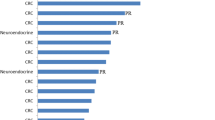Abstract
Irinotecan or CPT-11, a new inhibitor of the nuclear enzyme topoisomerase 1, is active in metastatic colorectal cancer (CRC). CPT-11 appeared to be superior to supportive care and continuous infusion of 5-FU in patients with metastatic CRC after failure to 5-FU (1-3). SN-38 is believed to be the active metabolite of CPT-11 and is produced by the enzyme carboxylesterase (4-7). Hepatic metabolism by glicuronidation and subsequent biliary excretion is the most important route of elimination of SN-38 (8-10).
Access this chapter
Tax calculation will be finalised at checkout
Purchases are for personal use only
Preview
Unable to display preview. Download preview PDF.
Similar content being viewed by others
References
Creemers G.J., Lund B. Verweij J.,1994, Topoisomerase I inhibitors. Topotecan and irinotecan. Cancer Treat Rev. 20: 73–96
Pinot H. C., 1997, Phase II trial of irinotecan in patients with metastatic colorectal carcinoma. J Clin Oncol 15: 2910–2919
Cunningham D., 1998, Randomized trial of irinotecan plus supportive care versus supportive care alone after fluorouracil failure in patients with metastatic colorectal cancer.Lancet, 352: 1413–1418
Iyer L., Raitan M.J.,1998, Clinical pharmacology of camptothecins. Cancer Chemother Pharmacol 42: 531–543
Chabot G.G., 1995, Population pharmacokinetics and pharmacodynamics of irinotecan (CPT-11) and active metabolite SN-38 during phase I trials. Ann Oncol 6: 141–151
Rivory L. P., Robert J.,1995, Identification and kinetics of a ß-glucuronide of SN-38 in human plasma after administration of the camptothecin derivative irinotecan (CPT-11). Cancer Chemother Pharmacol 36: 176–179
Gupta E., 1994, Metabolic fate of irinotecan in humans: correlation of glucuronidation with diarrhea. Cancer Res 54: 3723–3725
Van Groeningen C. J., 2000, Altered Pharmacokinetics and metabolism of CPT-11 in liver dysfunction: a need for guidelines. Clin Cancer Res 6: 1342–1346
Farabos C., 2000, Hepatic extraction, metabolism and biliary excretion of irinotecan in the isolated perfused rat liver. Proceedings of ASCO200 a, Abs 779
Kerr J. Z.,2000, A phase I study of irinotecan in pediatric patients: a pediatric oncology group study. Proceedings of ASCO, 200 a Abs 780
Fiorentini G., 2000, Global approach to hepatic metastases from colorectal cancer: indication and outcome of intra-arterial chemotherapy and other hepatic directed treatments. Med Oncol 17 163–173
Guichard S., 2000, CPT-11 converting carboxylesterase in tumor and normal colon and liver tissues. Proceeding of AACR 40: 340, Abs 2250
Van Groeningen C.J., 1997, Phase I clinical and pharmacokinetics study of 5 day CPT- 11 hepatic arterial infusion (HAI) chemotherapy. Proceedings of ASCO 16: 219a, Abs 768
Van der Vijgh W.J.F., 1998, Pharmacokinetics and pharmacodinamics of CPT-11 during 5 day hepatic arterial and intravenous infusion. Proceedings of AACR 39: 600, Abs 4082
Eisenhauer E., 2000 Phase I Clinical Trial Design in Cancer Drug Development. J Clin Oncol 18 3: 684–692
Longo GSA, 1998, Pretreatment of colon carcinoma cells with tomudex enhances 5-fluorouracil cytotoxicity. Clin Cancer Res 4: 469–473
Mans D.R., 1999, Sequence-dependent growth inhibition and DNA damage formation by the irinotecan 5-fluorouracil combination in human colon carcinoma cell lines. Eur J Cancer, 35: 1851–1861
Author information
Authors and Affiliations
Editor information
Editors and Affiliations
Rights and permissions
Copyright information
© 2002 Springer Science+Business Media New York
About this chapter
Cite this chapter
Fiorentini, G., Lucchi, S.R., Giovanis, P., Cantore, M., Guadagni, S., Papiani, G. (2002). Phase I Clinical Study of Irinotecan (CPT-11) Hepatic Arterial Infusion Chemotherapy in Hepatic Metastases from Colorectal Cancer: Preliminary Results. In: Habib, N.A. (eds) Multi-Treatment Modalities of Liver Tumours. Springer, Boston, MA. https://doi.org/10.1007/978-1-4615-0547-1_18
Download citation
DOI: https://doi.org/10.1007/978-1-4615-0547-1_18
Publisher Name: Springer, Boston, MA
Print ISBN: 978-1-4613-5126-9
Online ISBN: 978-1-4615-0547-1
eBook Packages: Springer Book Archive




